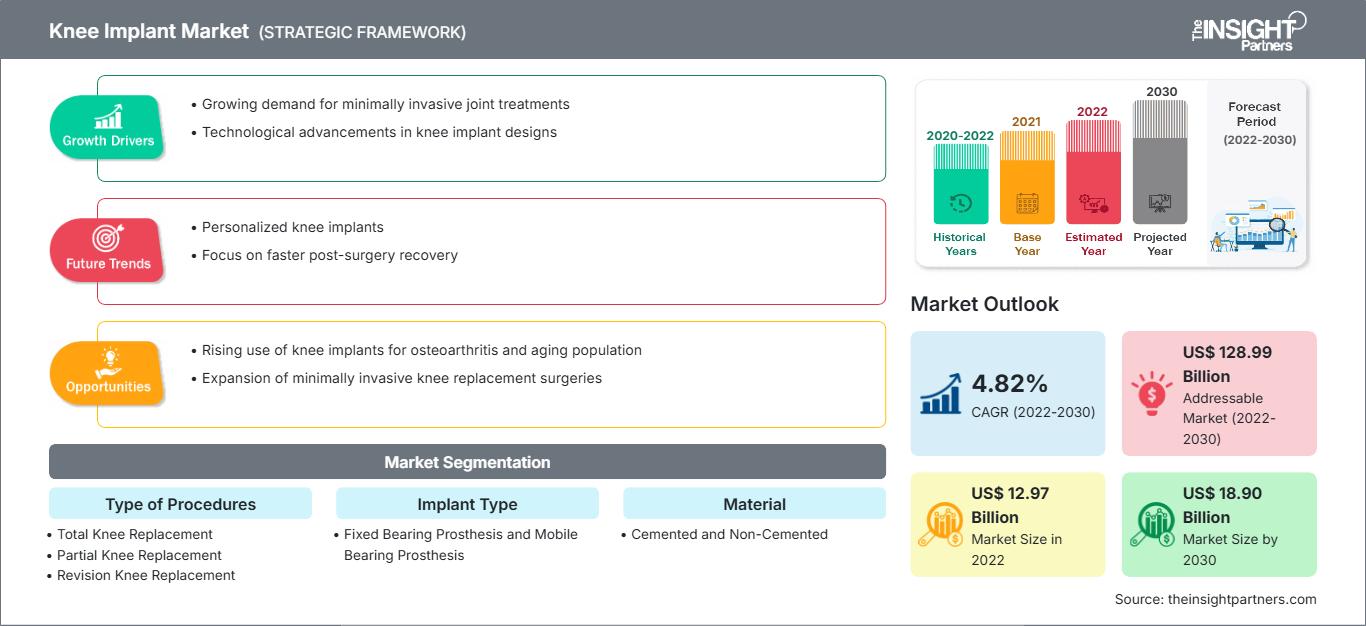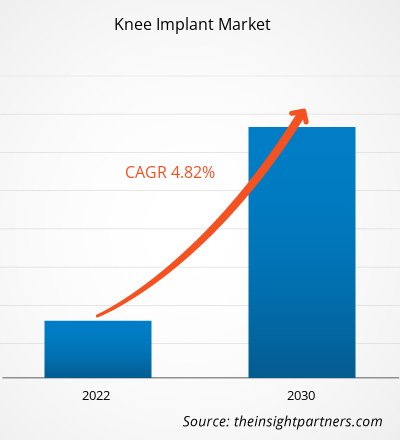Se prevé que el tamaño del mercado de implantes de rodilla alcance los 19.820 millones de dólares estadounidenses en 2031, frente a los 14.080 millones de dólares estadounidenses en 2024. Se espera que el mercado registre una tasa de crecimiento anual compuesta (TCAC) del 5,09% durante el período 2025-2031.
Análisis del mercado de implantes de rodilla
La demanda de implantes de rodilla está creciendo debido al aumento de la incidencia de la osteoartritis y al envejecimiento global de la población. Las innovaciones en biomateriales, la impresión 3D y las opciones quirúrgicas mínimamente invasivas mejoran la durabilidad de los implantes y la experiencia del paciente. Una mayor concienciación sobre la salud, políticas de reembolso favorables y una creciente demanda de opciones de reemplazo de rodilla personalizadas impulsan el crecimiento del mercado.
Panorama del mercado de implantes de rodilla
Los avances tecnológicos, como los implantes personalizados impresos en 3D y los procedimientos quirúrgicos mínimamente invasivos, están mejorando los resultados para los pacientes. El aumento del gasto sanitario, las políticas de reembolso favorables y la creciente concienciación en los mercados emergentes convierten a los implantes de rodilla en un segmento crucial del mercado de dispositivos médicos ortopédicos.
Obtendrá personalización gratuita de cualquier informe, incluyendo partes de este informe, análisis a nivel de país y paquetes de datos de Excel. Además, podrá aprovechar excelentes ofertas y descuentos para empresas emergentes y universidades.
Mercado de implantes de rodilla: Perspectivas estratégicas

-
Obtenga las principales tendencias clave del mercado que se describen en este informe.Esta muestra GRATUITA incluirá análisis de datos, que abarcarán desde tendencias de mercado hasta estimaciones y pronósticos.
Factores impulsores y oportunidades del mercado de implantes de rodilla
Factores que impulsan el mercado:
- Envejecimiento de la población: El aumento mundial de la población de edad avanzada provoca, con el tiempo, la aparición de enfermedades articulares degenerativas como la osteoartritis, lo que afecta enormemente a la necesidad de cirugías de reemplazo de rodilla e implantes.
- Avances tecnológicos: El desarrollo de los materiales de implante, la robótica y las tecnologías de impresión 3D es la razón de los mejores resultados después de la operación, la mayor vida útil del implante y el menor tiempo de recuperación, lo que hace que los pacientes estén más dispuestos a someterse a una cirugía de reemplazo de rodilla.
Oportunidades de mercado:
- Expansión en mercados emergentes: Las regiones en desarrollo, como Asia Pacífico y América Latina, ofrecen un potencial sin explotar debido al crecimiento de la infraestructura sanitaria, el aumento de los ingresos y una mayor concienciación sobre las opciones de reemplazo articular.
- Implantes personalizados: Existe una creciente demanda de implantes específicos para cada paciente, diseñados mediante técnicas avanzadas de imagen y fabricación, que ofrecen un mejor ajuste, una función mejorada y una mayor satisfacción del paciente después de la cirugía.
Análisis de segmentación del informe de mercado de implantes de rodilla
El mercado de implantes de rodilla se segmenta en diversas categorías para ofrecer una comprensión más clara de su funcionamiento, potencial de crecimiento y tendencias actuales. A continuación, se presenta el enfoque de segmentación estándar utilizado en los informes del sector:
Por tipo de procedimiento:
- Reemplazo total de rodilla
- Reemplazo parcial de rodilla
- Revisión de reemplazo de rodilla
Por tipo de implante:
- Prótesis de rodamiento fijo
- Prótesis de rodamiento móvil
Por material:
- Cementado
- No cementado
Por usuario final:
- hospitales
- Clínicas Ortopédicas
- Centros quirúrgicos ambulatorios
- Otros
Por geografía:
- América del norte
- Europa
- Asia Pacífico
- América Latina
- Oriente Medio y África
Perspectivas regionales del mercado de implantes de rodilla
Los analistas de The Insight Partners han explicado en detalle las tendencias y los factores regionales que influyen en el mercado de implantes de rodilla durante el período de previsión. Esta sección también analiza los segmentos y la geografía del mercado de implantes de rodilla en Norteamérica, Europa, Asia Pacífico, Oriente Medio y África, y Sudamérica y Centroamérica.
Alcance del informe de mercado de implantes de rodilla
| Atributo del informe | Detalles |
|---|---|
| Tamaño del mercado en 2024 | 14.080 millones de dólares estadounidenses |
| Tamaño del mercado para 2031 | 19.820 millones de dólares estadounidenses |
| Tasa de crecimiento anual compuesto global (2025 - 2031) | 5,09% |
| Datos históricos | 2021-2023 |
| período de previsión | 2025-2031 |
| Segmentos cubiertos |
Por tipo de procedimiento
|
| Regiones y países cubiertos |
América del norte
|
| Líderes del mercado y perfiles de empresas clave |
|
Densidad de los actores del mercado de implantes de rodilla: comprensión de su impacto en la dinámica empresarial
El mercado de implantes de rodilla está creciendo rápidamente, impulsado por la creciente demanda de los usuarios finales debido a factores como la evolución de las preferencias de los consumidores, los avances tecnológicos y una mayor conciencia de los beneficios del producto. A medida que aumenta la demanda, las empresas amplían su oferta, innovan para satisfacer las necesidades de los consumidores y aprovechan las nuevas tendencias, lo que impulsa aún más el crecimiento del mercado.

- Obtenga una visión general de los principales actores del mercado de implantes de rodilla.
Análisis de la cuota de mercado de implantes de rodilla por geografía
La industria de implantes de rodilla se caracteriza por su diversidad geográfica. Norteamérica lidera el mercado, beneficiándose de una atención médica de calidad superior, el aumento de casos de osteoartritis y los avances tecnológicos en salud. Le sigue Europa, donde la población de edad avanzada y los seguros médicos son los principales factores que influyen en el mercado. La región de Asia Pacífico está experimentando un rápido crecimiento, impulsado por el aumento de las inversiones en salud y el envejecimiento de la población en China e India. Asimismo, Oriente Medio y África, y Latinoamérica, representan áreas con un gran potencial para la atención ortopédica y una accesibilidad aún sin explotar.
El crecimiento del mercado de implantes de rodilla varía según las regiones debido a factores como el envejecimiento de la población y la creciente prevalencia de trastornos relacionados con la movilidad, que impulsan la demanda de terapias basadas en implantes de rodilla. A continuación, se presenta un resumen de la cuota de mercado y las tendencias por región:
1. Norteamérica
- Cuota de mercado: Posee una parte significativa del mercado global.
-
Factores clave:
- Aumento de la población anciana
- Avances tecnológicos
- Tendencias: Reemplazo articular en régimen ambulatorio
2. Europa
- Cuota de mercado: Cuota de mercado sustancial
-
Factores clave:
- Políticas de reembolso favorables
- Creciente población de la tercera edad
- Tendencias: Aumento del turismo médico
3. Asia Pacífico
- Cuota de mercado: Región de mayor crecimiento, con una cuota de mercado en aumento cada año.
-
Factores clave:
- Ampliando el acceso a la atención médica
- Aumento de los casos de osteoartritis
- Tendencias: Auge de la manufactura nacional
4. Sudamérica y Centroamérica
- Cuota de mercado: Mercado en crecimiento con progreso constante
-
Factores clave:
- Urbanización y cambios en el estilo de vida
- Creciente sector de la atención médica privada
- Tendencias: Crecimiento de los seguros de salud
5. Oriente Medio y África
- Cuota de mercado: Mercado en crecimiento con progreso constante
-
Factores clave:
- Inversión creciente en atención médica
- Aumento de la esperanza de vida
- Tendencias: Centros de Excelencia Ortopédica
Densidad de los actores del mercado de implantes de rodilla: comprensión de su impacto en la dinámica empresarial
Alta densidad de mercado y competencia
Una de las ventajas competitivas que tiene la competencia en este mercado es la presencia de empresas bien establecidas, entre las que podemos mencionar Zimmer Biomet y Stryker Corporation.
Este alto nivel de competencia impulsa a las empresas a diferenciarse ofreciendo:
- Productos avanzados
- Servicios de valor añadido como la personalización y las soluciones sostenibles
- Modelos de precios competitivos
- Cumplimiento de las directrices reglamentarias
Oportunidades y movimientos estratégicos
- Junio de 2024: Zimmer Biomet firmó un acuerdo de distribución con THINK Surgical, Inc. para ampliar la exposición al sistema robótico de rodilla TMINI para cortes óseos robóticos y planificación 3D.
- Enero de 2024: Zimmer Biomet presentó el implante de rodilla inteligente Persona IQ que monitoriza la recuperación en tiempo real.
Las principales empresas que operan en el mercado de implantes de rodilla son:
- Zimmer Biomet Holdings Inc.
- Smith & Nephew plc
- DePuy Synthes (Johnson & Johnson MedTech)
- Corporación Stryker
- Medacta International SA
- Conformis Inc.
- Arthrex Inc.
- Exactech Inc.
- Corporación Científica MicroPort
- LimaCorporate SpA
- Corporación Enovis (DJO Global)
- Sistemas de implantes Aesculap (B. Braun)
- Grupo Corin
- Medtronic plc
- Corporación CONMED
- THINK Surgical Inc.
- Corporación Ortopédica Unida
- Maxx Orthopedics Inc.
- OrthAlign Inc.
- Exatech Inc.
Descargo de responsabilidad: Las empresas enumeradas anteriormente no están clasificadas en ningún orden en particular.
Otras empresas analizadas durante el transcurso de la investigación:
- ARTIQO GmbH
- Hospital de Cirugía Especial (HSS)
- Kinamed Inc.
- B. Braun SE
- Uteshiya Medicare
- Dispositivos médicos Evonic
- Sistema Physica (MicroPort)
- SurgTech Inc.
- LINK Ortopedia
- Rotación medial de rodilla (MRK)
- Compañía de aparatos médicos Waston
- BBRAUN Aesculap
- Rodilla ATTUNE (DePuy)
- VIAJE II (Smith & Nephew)
- Sistema K-MONO (Medacta)
- GKS PRIME Flex TRASER
- Unicompartimental (Corin)
- Colón (Esculapo)
- Optetrak Logic (Exactech)
- iUni (Conformis)
Noticias y novedades del mercado de implantes de rodilla
- Octubre de 2024: Smith+Nephew lanzó el sistema de rodilla articulada LEGION en los EE. UU., dirigido a.
- Marzo de 2023: Stryker lanzó Mako Total Knee 2.0, un avance en la robótica inteligente para el reemplazo de rodilla.
Cobertura y resultados del informe de mercado de implantes de rodilla
El informe "Tamaño y pronóstico del mercado de implantes de rodilla (2021-2031)" proporciona un análisis detallado del mercado que abarca las siguientes áreas:
- Tamaño y pronóstico del mercado de implantes de rodilla a nivel mundial, regional y nacional para todos los segmentos clave del mercado cubiertos en el alcance.
- Tendencias del mercado de implantes de rodilla, así como la dinámica del mercado, como los impulsores, las restricciones y las oportunidades clave.
- Análisis detallado de PEST y SWOT
- Análisis del mercado de implantes de rodilla que abarca las principales tendencias del mercado, el marco global y regional, los principales actores, las regulaciones y los desarrollos recientes del mercado.
- Análisis del panorama industrial y la competencia, incluyendo la concentración del mercado, el análisis de mapas de calor, los principales actores y los desarrollos recientes del mercado de implantes de rodilla.
- Perfiles detallados de las empresas
- Análisis histórico (2 años), año base, pronóstico (7 años) con CAGR
- Análisis PEST y FODA
- Tamaño del mercado, valor/volumen: global, regional y nacional
- Industria y panorama competitivo
- Conjunto de datos de Excel
Informes recientes
Testimonios
Razón para comprar
- Toma de decisiones informada
- Comprensión de la dinámica del mercado
- Análisis competitivo
- Información sobre clientes
- Pronósticos del mercado
- Mitigación de riesgos
- Planificación estratégica
- Justificación de la inversión
- Identificación de mercados emergentes
- Mejora de las estrategias de marketing
- Impulso de la eficiencia operativa
- Alineación con las tendencias regulatorias






















 Obtenga una muestra gratuita para - Mercado de implantes de rodilla
Obtenga una muestra gratuita para - Mercado de implantes de rodilla